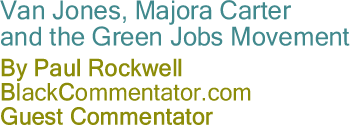In February 2006,
Majora Carter, co-founder of Green For All, delivered an impassioned
address to a gathering of environmentalists. When she held up a
poster that read “Green is the new Black,” the audience burst into
applause.
Carter, a close associate of
Van Jones, author of The
Green Collar Economy: How One Solution Can Fix Our Two Biggest Problems (Harper Collins, 2008), grew up across the street from a crack
house in the South Bronx, at a time when whites fled to the suburbs,
and when landlords torched their own apartment buildings to collect
insurance.
(Harper Collins, 2008), grew up across the street from a crack
house in the South Bronx, at a time when whites fled to the suburbs,
and when landlords torched their own apartment buildings to collect
insurance.
While the South Bronx is the
birthplace of rap music, break dancing - Hip Hop’s irrepressible
culture - the historic borough is also an environmental calamity,
the poorest Congressional district in the United States. Nearly
50% of its residents live below the poverty line, and New
York City transfers 40% of its waste into the South
Bronx. Dissected by three unwanted thruways, the borough encompasses
a sludge plant, four power plants, and has the lowest park-to-people
ratio in New York City.
Sixty thousand diesel trucks pass through the area each week. While
75% of community residents do not own their own cars, all of the
residents breathe the fumes and exhaust, and one in four children
suffers from asthma, caused in large part by industrial and auto
pollution. Hospital emergency rooms are often the primary care facilities
for the uninsured poor.

And those made sick - those
most victimized by fossil-fuel industries - often bear the least
responsibility for climate change and pollution.
South Bronx
environmental activist, Majora Carter, told CNN recently, “If power
plants, waste handling, chemical plants and transport systems were
located in wealthy areas as quickly and easily as in poor areas,
we would have had a clean, green economy decades ago.”
 Because
of Carter’s innovative social work in recent years, the borough
that gave Hip Hop to the world is once again making history. Green
history. Because
of Carter’s innovative social work in recent years, the borough
that gave Hip Hop to the world is once again making history. Green
history.
A few years ago Carter leveraged
a $10,000 grant into a $3 million eleven-mile waterfront park. The
green-the-ghetto movement was born. Carter became Executive Director
of Sustainable South Bronx, an organization that alleviates poverty
through environmental projects, like recycling and urban agriculture.
The Stewardship Training program is exemplary. It moves the poor,
especially youth, into living-wage green-collar jobs. Many of the
students have prison records or were previously on public assistance.
Therein is the premise of the burgeoning green economy: Nothing
is wasted. All human energy is renewable. According to Ms. Carter,
85% of trainees and workers in the four-year program land steady
green jobs in urban forestry, or green-roof installation and maintenance,
or other entry-level jobs.
 Back
in 1995, David Brower, America’s
most influential conservationist, a mountaineer and lover of wild
things, identified the South Bronx and unemployment
as environmental issues. In Let
the Mountains Talk, Let the Rivers Run: A Call to Save the Earth Back
in 1995, David Brower, America’s
most influential conservationist, a mountaineer and lover of wild
things, identified the South Bronx and unemployment
as environmental issues. In Let
the Mountains Talk, Let the Rivers Run: A Call to Save the Earth (Harper Collins, 1995), he wrote: “Restoration means putting
the Earth’s life support systems back in working order: rivers,
forests, wetlands, deserts, soil, and endangered species, too...”
Some of his predominately white, middle-class readers might have
been surprised when he continued: ”Human systems also need restoration.
Let’s rehabilitate the South Bronx, and all
the other places like it across the Earth. To accomplish that we
must give the unemployed and the never-employed a stake in the wider
restoration process.”
(Harper Collins, 1995), he wrote: “Restoration means putting
the Earth’s life support systems back in working order: rivers,
forests, wetlands, deserts, soil, and endangered species, too...”
Some of his predominately white, middle-class readers might have
been surprised when he continued: ”Human systems also need restoration.
Let’s rehabilitate the South Bronx, and all
the other places like it across the Earth. To accomplish that we
must give the unemployed and the never-employed a stake in the wider
restoration process.”
Today Van Jones, a solution-oriented
environmentalist, puts it more succinctly: “We are either going
to create a whole lot of more green jobs or we’re going to have
a dead planet.”
Oakland,
California
The South
Bronx is not alone. Many other communities are adopting a green
economic development strategy. In 2007, without any fanfare, Congress
enacted a Green Jobs Act, providing a modest amount of money - $125
million - for workforce training in the clean energy sector. Today
the bill is especially significant, not because of the size of the
appropriation (which is mere pocket change), but because it promotes
green jobs for the poor. The bill ensures training for at-risk youth,
ex-prisoners, returning veterans, and families that fall well below
the poverty line. Green collar jobs are “career-track jobs,” says
Van Jones. They’re family-supporting gigs that contribute to preserving
and enhancing the environment. Installation of solar panels, construction
and maintenance of wind turbines, urban agriculture, tree planting
in cities, weatherization and retrofitting of buildings, remediation
of brownfields (cleaning up abandoned, often-contaminated industrial
sites), recycling and reuse of materials - these are jobs that generate
local revenue, save energy, clean the environment, and cannot be
exported.
The Green Jobs Corps campaign,
inspired by Van Jones and the Ella Baker
Center, began in Oakland. Olivia Caldwell is a young, single mother who lives in Oakland.
Like the South Bronx, her community suffers
from high unemployment, foreclosures, and violent crime. Olivia
herself served time for petty theft.
 When
she was released from prison, Oakland’s Green Job Corps changed her life. Backed by local trade unions
and community colleges, 40 paid trainees were prepared for green
construction jobs, primarily in solar panel installation. The program
worked, and today, small as it may be in size, it is a microcosm
for the future. As Mayor Ron Dellums put it: “This is an extraordinary
effort. Elegant in its simplicity and embrace. You can fight pollution
and poverty simultaneously.” For the first time in their lives,
impoverished youth have a tangible stake in climate change solutions. When
she was released from prison, Oakland’s Green Job Corps changed her life. Backed by local trade unions
and community colleges, 40 paid trainees were prepared for green
construction jobs, primarily in solar panel installation. The program
worked, and today, small as it may be in size, it is a microcosm
for the future. As Mayor Ron Dellums put it: “This is an extraordinary
effort. Elegant in its simplicity and embrace. You can fight pollution
and poverty simultaneously.” For the first time in their lives,
impoverished youth have a tangible stake in climate change solutions.
“We want the federal government
to buy into what is taking place here in Oakland,”
said Congresswoman Barbara Lee (D-CA). “Once the federal government
buys in, I believe our nation can see what can be done. We must
go green.”
The Green jobs movement, so
timely in the current economic debacle, concerns every region of
the country. Here are a few examples.

Iowa
Iowa lies
on the edge of the Great Plains, “the Saudi
Arabia of wind.” A few years ago, 1800 employees
lost their jobs at a Maytag factory in Newton, Iowa. Within a year, however, the old
factory was re-tooled, and it is presently being converted into
a plant that produces wind-turbines, the fastest growing sector
of the clean energy market in the world. Wind turbines produce electricity
for local communities, factories, homes. The power is clean, renewable,
and widely available.
Hundreds of Iowa’s
laid-off workers are now returning to updated plants to work, not
in the obsolete pollution economy, but in the green economy. These
workers may not eat tofu, sit in hot tubs, or pay extra cash for
organic foods. But make no mistake, they are converts to clean energy
and social-uplift environmentalism. Arie Versendaal, who worked
for three decades at Maytag, now commends the green economy. “Life’s
not over,” he told a New York Times reporter. “For 35 years
I pounded my body. Now I feel like I’m doing something beneficial
for mankind...The wind is blowing out here for anybody to use.”
(New York Times, November 12, 2008)
Larry Crady, who lays fiberglass
for turbine moldings said: “I like this job...I feel I’m doing something
to improve our country. This is going to be the future.”

Los
Angeles
Los
Angeles is already getting prepared for the green economy. In June
2007 the Los Angeles City Council established a City Retrofit jobs
task force. The Apollo Alliance, a major player in the new economy,
is encouraging L.A. to invest in water and energy retrofits. More than 1100 L.A.
buildings are deteriorating, and the program could save the city
up to $10 million a year in utility costs.
Energy efficiency is crucial
to environmental restoration. Buildings in the U.S.
are responsible for 36% of our energy use, about 30% of greenhouse-gas
emissions, and 30% of waste production. “The cleanest energy is
the energy that we never have to use,” writes Van Jones. Weatherization
and retrofitting provide entry-level jobs, with opportunities for
advancement, the kind of jobs that cannot be outsourced. The most
important tool in the green economy, Van Jones notes, is the caulk
gun.
Sacred Earth, the Dignity
of Labor
“Green the ghetto!” “Green jobs
for all!” Green jobs, not jails!!” “Green is the new Black.” These
are some of the refreshing slogans and motifs of a new wave, a more
inclusive, more economically savvy environmental movement.
In her latest book on earth
democracy, Soil, not Oil (South End Press, 2008), India’s
Ghandian environmentalist, Vandana Shiva, writes: “Two crises of
our times are intimately connected - the climate crisis and the
unemployment crisis. As long as we address these crises separately,
we will not solve either.”
 For
many decades the environmental movement in the U.S. lacked a practical
economic agenda. As a result, the oil and auto industries dominated
elections and convinced too many voters that environmentalism threatens
jobs and economic stability. The oil industry even convinced the
AFL-CIO to lobby against the Kyoto Protocol. For
many decades the environmental movement in the U.S. lacked a practical
economic agenda. As a result, the oil and auto industries dominated
elections and convinced too many voters that environmentalism threatens
jobs and economic stability. The oil industry even convinced the
AFL-CIO to lobby against the Kyoto Protocol.
As climate and economic calamities
converge, consciousness changes. Now the tables are turned. Far
from threatening jobs, the environmental agenda actually constitutes
the only practical, sustainable means for long-term economic revival.
The green jobs movement is turning
into an international force. In a short article, “What the World
Needs is a Green New Deal,” (S.F. Chronicle, 11/26/08), Ban
Ki Moon, Secretary-General of the United Nations, writes: “At a
time when the global economy is sputtering, we need growth. At a
time when unemployment in many nations is rising, we need new jobs...Only
sustainable development - a global embrace of green growth - offers
the world, rich nations as well as poor, an enduring prospect of
long-term social well-being and prosperity...A solution to poverty
is also a solution for climate change: green growth.”
At long last, the new president
is an environmentalist. Obama recently picked Representative Hilda
Solis, a Latina, for Secretary of Labor. With the help of Van Jones and Green
For All, it was Solis that authored the Green Jobs Act, and Van
Jones’ The Green Collar Economy may well become the most
influential resource for the Obama Administration. The book is replete
with examples of green U.S.
jobs in the fledgling clean energy economy.  But
while this remarkable work offers prescriptions for economic growth,
it’s also a visionary work suffused with refreshing spirituality.
Van Jones not only reawakens our sense of awe, our reverence for
nature; he also renews America’s long-suppressed respect for the dignity
of all labor. But
while this remarkable work offers prescriptions for economic growth,
it’s also a visionary work suffused with refreshing spirituality.
Van Jones not only reawakens our sense of awe, our reverence for
nature; he also renews America’s long-suppressed respect for the dignity
of all labor.
Labor, after all, is a renewable
source of energy. And we cannot harness the geothermal energy of
the inner earth, or the powers of the wind and sun, until we also
harness the untapped creativity and yearnings of the poor, who still
(43 years after the Great Society) languish in ghettos, barrios,
and reservations of misery and neglect.
The Green Jobs Corps connects
America’s poor to the noblest aim of humankind
today: the restoration of nature’s ecosystems, the fragile networks
of mutuality that sustain all life.

BlackCommentator.com
Guest Commentator, Paul Rockwell, is a national columnist and formerly
an assistant professor of philosophy at Midwestern University. He lives in the San
Francisco Bay Area. He can be reached at
Click here
to contact Mr. Rockwell. |







































 Back
in 1995, David Brower,
Back
in 1995, David Brower,  When
she was released from prison,
When
she was released from prison, 

 For
many decades the environmental movement in the
For
many decades the environmental movement in the 





